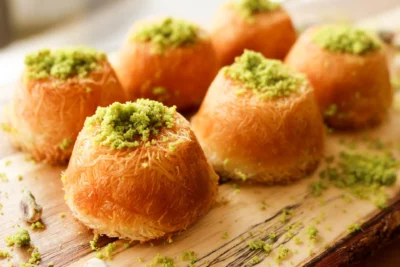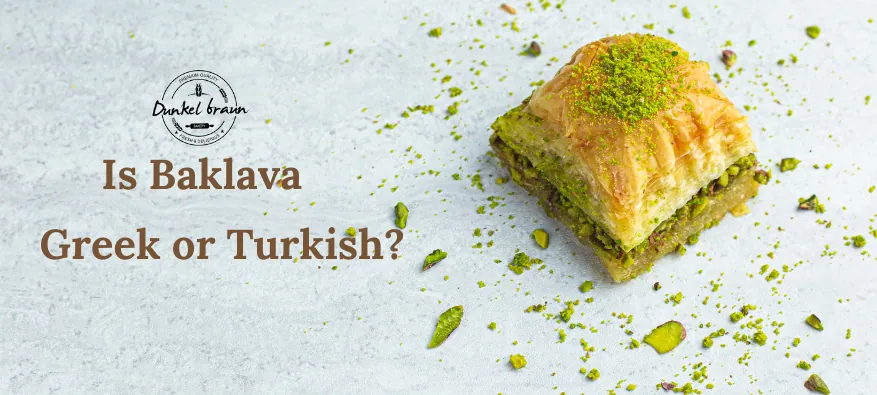The debate over is Baklava Greek or Turkish has been ongoing for centuries, with both sides claiming the sweet, syrupy pastry as their own.
Baklava is one of the most beloved pastries of the Mediterranean region, and its origin has been disputed for centuries. Though both countries have a rich history of producing and enjoying the sweet treat, the question of whether it is baklava Greek or Turkish has been a source of debate.
In the midst of debate over whether or where the baklava sweet originated, and from various contradictory sources, the story of origination keeps changing.
It has a rich history and has been enjoyed for centuries. And here at Dunkel braun we already have discussed about the history of the Baklava sweet. You can easily learn about it through our blog, – Top 3 Turkish Sweets Baklava: A World of Deliciousness and learn about the origin story of this dessert.
For those who don’t know what is baklava sweet? A simple definition that I can provide is Baklava is a dessert made from thin layers of phyllo dough filled with chopped nuts, sugar, and spices and soaked in honey or syrup.
But beyond just being a tasty treat, Baklava has become a symbol of national pride for both Greece and Turkey.
In this blog post, we’ll look at the cultural significance of Baklava in both Greece and Turkey, as well as how the dish’s flavor and preparation differ between the two nations. Whether you prefer Baklava Greek or Turkish, this post will provide an interesting insight into this delicious dessert.
Key Differences in Baklava Greek and Turkish Baklava
If you raise the question is baklava Greek or Turkish, the answer to that is quite complicated. Although the dessert became quite popular through various Greek restaurants, and there is no way to pinpoint where it originated, it is said that the baklava sweet came from modern day Turkey (the Ottoman Empire) and was modernized in today’s Greece.
The ethnic Greek traders that traveled across the empire are credited with bringing the current form of baklava from the Middle East to the western portions of the country.
The term phyllo, which refers to thin sheets of dough, is derived from the Greek word for leaf. In contrast, the term baklava is thought to have Turkish origins.
Traditionally, the Turkish baklava desert is considered to be the most conventional desert in the world. But both Greece and Turkey have their own version of baklava, and here, let’s go through some of the key points that you can understand when you taste one, whether it’s a Greek or Turkish one.

Difference in Filling
In traditional Turkish baklava, the most prime and exclusive choice of chopped nuts is pistachio, but many times, as an alternative, walnuts are also used.
While in the case of Greek baklava, the primary nut that is used is the walnut. A mixture of other type of nuts is used as filling in these sweets of baklava greek like pistachios, hazelnuts or pecans.
The Greek version of baklava often contains cinnamon, while the Turkish version contains rosewater.
Difference in Preparation of Syrup
Turkish baklava is traditionally soaked in a sweet syrup made with a combination of water, sugar, and lemon juice.
On the other hand, Greek baklava may use a syrup made with honey, as well as a combination of sugar, water, and honey flavored with spices like cloves and cinnamon.
Individual preferences and regions can influence the exact recipe for the syrup.
Difference in Butter
In a traditional and authentic baklava greek recipe, the type of butter that is used in making is called ‘galakots’ made out of the milk of both sheep and goats together.
While in the traditional Turkish baklava only pure butter is used and nothing else.
Difference in Taste and Texture
Greek baklava has a delicate, crisp texture with layers of flaky crust and a mildly spiced, nutty flavor. It is created with thinner phyllo pastry and a nut filling generally seasoned with cinnamon.
The syrup in Greek baklava imparts a sweet and flowery flavor, as well as a slightly sticky texture. The baklava Greek region has a much softer texture due to the thick syrup.
On the other hand, the Turkish baklava, with its thicker, heavier dough and filling entirely with pistachios, has a more substantial, chewy texture and a rich, nutty flavor. Turkish baklava syrup is often created using a combination of water, sugar, and honey, or just honey, resulting in a sweet, flowery flavor with a thick, syrupy texture.
With these pointers, it is true that both of the recipes from Greece and Turkey have their differences, but at the same time, a foodie’s heart cannot decide which one is right. To sum it up, we at Dunkel braun have drawn inspiration for our baklava recipe from around the world.
Let’s know how you can prepare a Baklava Greek Sweet.
Recipe for Baklava Greek
Preparation time – 1 hour
Serving – 18
Ingredients:
- 1 lb. phyllo pastry sheets
- 1 ½ cups unsalted butter, melted
- 2 cups of mixed nuts (walnuts, almonds, and pistachios), chopped
- 1 tsp. ground cinnamon
- 1 cup granulated sugar
- 1 cup water
- 1 cup honey
- 2 cinnamon sticks
- 2 whole cloves
- 1 lemon, sliced
Directions:
- Preheat your oven to 350°F (175°C).
- Grease a 9×13 inch baking dish with some of the melted butter.
- In a large mixing bowl, combine the chopped nuts with the ground cinnamon and mix well.
- Brush a sheet of phyllo pastry with melted butter and place it in the bottom of a prepared baking dish. Repeat with 7 additional phyllo pastry sheets, brushing each layer with melted butter.
- One-third of the nut mixture should be sprinkled on top of the phyllo layers.
- Brush another sheet of phyllo dough with melted butter on top of the nuts. Repeat with 7 additional phyllo pastry sheets, brushing each layer with melted butter.
- Sprinkle another third of the nut mixture over the top of the phyllo layers.
- Repeat the layering process with 8 more sheets of phyllo pastry and the remaining nut mixture.
- Finish by stacking the remaining phyllo sheets on top of the nut mixture, generously coating each layer with melted butter.
- Using a sharp knife, carefully cut the baklava into diamond shapes.
- Bake in the preheated oven for 45-50 minutes, or until the baklava is golden brown.
- In a saucepan, combine the granulated sugar, water, honey, cinnamon sticks, cloves, and lemon slices while the baklava is baking. Bring to a boil, stirring regularly, over medium heat until the sugar dissolves.
- Lower the heat to low and continue to cook for 15-20 minutes, or until the syrup thickens somewhat.
- Take the baklava from the oven and quickly drizzle with the hot syrup, making sure to get it into all the nooks and crevices.
- Before serving, allow the baklava to cool fully. Enjoy!

Greek and Turkish baklava are both popular and delicious treats, but for those looking for a gourmet experience, there are many options available.
Now you may wonder where in Kolkata you can find this type of gourmet baklava, and we have Dunkel braun as your always go to option. Here, you can find the baklava box filled with different varieties and versions of the dessert.
One such option is to order baklava online, where you can find a variety of high-quality, artisanal baklava from around the world. With Dunkel braun, you can trust that you’ll be receiving the highest quality product, made with care and attention to detail.
So, whether you’re a baklava enthusiast or just looking to try something new, consider ordering a gourmet baklava box online. With the variety of flavors and styles available, you’re sure to find something to satisfy your sweet tooth. And with companies like Dunkel braun, you can trust that you’ll be receiving a truly exceptional product.


